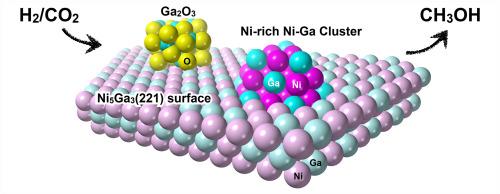Formation of Ni-rich Ni-Ga alloy clusters on the (221) surface of Ni5Ga3 intermetallic compounds during CO2 hydrogenation: An in-situ TEM study
IF 8.2
2区 材料科学
Q1 MATERIALS SCIENCE, MULTIDISCIPLINARY
引用次数: 0
Abstract
Ni-Ga alloys are the most promising bimetallic alloy catalysts for CO2 hydrogenation due to their high activity and selectivity. This study used in-situ transmission electron microscopy (TEM) to clarify the structural changes in the Ni5Ga3 intermetallic compound catalysts during the CO2 oxidation and CO2 hydrogenation processes. The results showed that as the temperature increased from 50 °C to 300 °C under CO2 conditions, crystalline Ga oxides, primarily the β-Ga2O3 phase, formed on the Ni5Ga3(211) surface, resulting in the formation of parallel moiré fringes. At the same time, Ni-rich Ni-Ga alloy nanoclusters appeared due to the excess Ni on the surface. Under H2/CO2 conditions, Ni-rich Ni-Ga alloy nanoclusters were also observed, but the formation of Ga oxide was limited. Electron energy loss spectroscopy (EELS) analysis also revealed the presence of Ga oxide but not Ni oxide phase.

CO2加氢过程中Ni5Ga3金属间化合物(221)表面富Ni-Ga合金团簇形成的原位TEM研究
Ni-Ga合金具有高活性和选择性,是最有前途的双金属合金催化剂。本研究利用原位透射电镜(TEM)研究了Ni5Ga3金属间化合物催化剂在CO2氧化和CO2加氢过程中的结构变化。结果表明:在CO2条件下,温度从50℃升高到300℃,在Ni5Ga3(211)表面形成以β-Ga2O3相为主的晶状Ga氧化物,形成平行的摩尔条纹;同时,由于表面过量的Ni,形成了富Ni的Ni- ga合金纳米团簇。在H2/CO2条件下,也可以观察到富Ni-Ga合金纳米团簇,但Ga氧化物的形成受到限制。电子能量损失谱(EELS)分析也发现了氧化Ga相的存在,但没有发现氧化Ni相。
本文章由计算机程序翻译,如有差异,请以英文原文为准。
求助全文
约1分钟内获得全文
求助全文
来源期刊

Materials Today Nano
Multiple-
CiteScore
11.30
自引率
3.90%
发文量
130
审稿时长
31 days
期刊介绍:
Materials Today Nano is a multidisciplinary journal dedicated to nanoscience and nanotechnology. The journal aims to showcase the latest advances in nanoscience and provide a platform for discussing new concepts and applications. With rigorous peer review, rapid decisions, and high visibility, Materials Today Nano offers authors the opportunity to publish comprehensive articles, short communications, and reviews on a wide range of topics in nanoscience. The editors welcome comprehensive articles, short communications and reviews on topics including but not limited to:
Nanoscale synthesis and assembly
Nanoscale characterization
Nanoscale fabrication
Nanoelectronics and molecular electronics
Nanomedicine
Nanomechanics
Nanosensors
Nanophotonics
Nanocomposites
 求助内容:
求助内容: 应助结果提醒方式:
应助结果提醒方式:


